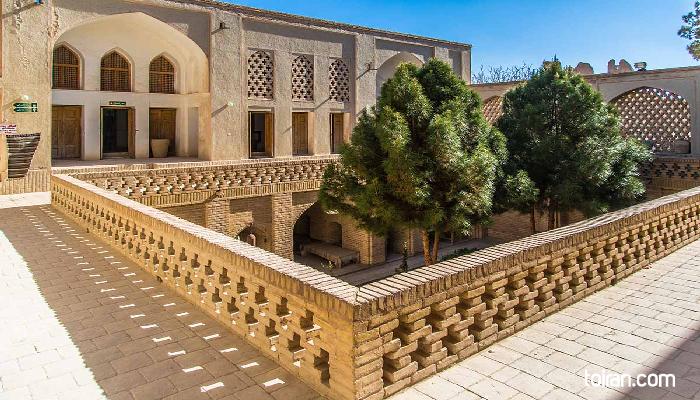Pirnia House is a Safavid (1501-1722) structure and one of the best examples of desert architecture. Situated directly across from the Naein Jame Mosque, the house was originally the residence of the governor of Naein and was later passed on to the Pirnia family in the Qajar era (1785-1925).
The house includes an entrance, Hashti (vestibule), Shahneshin balcony, corridors, garden, backyard, Birouni (space used by men and guests) and Andarouni (Space used by women and servants). One of the main features of the house is the wall paintings and stucco reliefs in the Shahneshin balcony, governor’s office and hall of ceremonies some of which feature poems.
There are poems written next to some of the wall paintings in the Shahneshin balcony. The stucco reliefs are in the form of frames and depict stories from The Seven Beauties of poet Nezami Ganjavi (1141-1209) and feature the tales of Khosrow and Shirin, Joseph and Zuleika, hunting scenes and other romantic stories. The wall paintings also feature floral and geometric motifs, bird and flower designs, dragons and other animals.
Designed to be lower than the house, the courtyard has fig and pistachio trees as well as grape vines and a large pool (howz). The design of the courtyard ensured it always remained cool and therefore, it functioned as a summer living room for the Pirnia family.
Pirnia House became the location of the Desert Anthropology Museum in 1995 and showcases clothing, tools, metal and wooden vessels, and handicrafts as well as the customs, culture and beliefs of the inhabitants of the desert regions of Iran.
This 400-year-old house was registered as a National Heritage Site in 1978.


It's amazing how they came up with such an architecture design way back then as soon as you enter the house you will notice the desert heat perishing and the cool brees will heat you. There is a room into the left entrance of the house where you can see the master working on an ancient Kilim Weaving machine and he will explain how it works. Overall it is a nice but short visit.